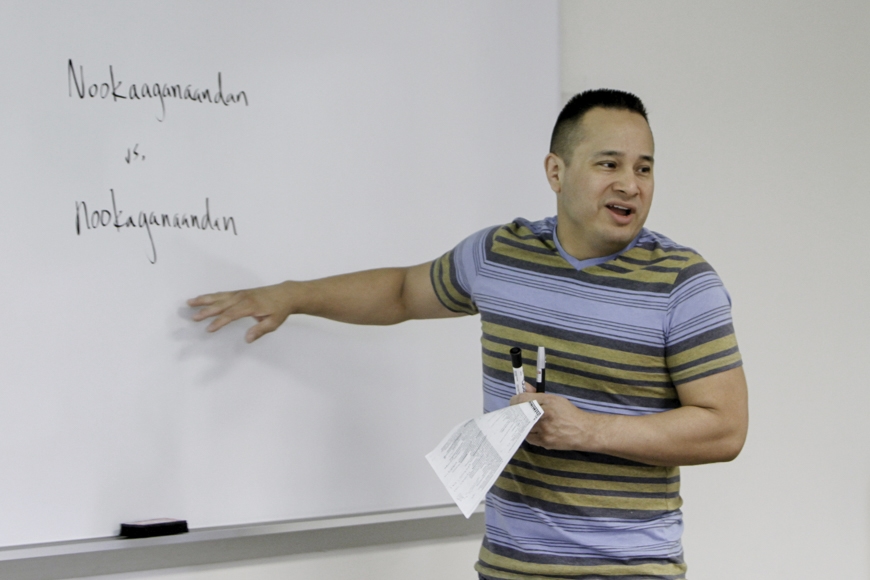Preserving a People: Reversing the Decline of Ojibwe Language
Estimates claim that there are as few as 1,000 Native speakers of Ojibwe in the United States; a language that once predominated the Midwest is disappearing. Professor Brendan Fairbanks, who is Ojibwe and Kickapoo, is combating this through education.
Fairbanks and his Department of American Indian Studies (AIS) colleagues are also concerned by the low number of Native students, especially from reservations, attending the University. While there are many reasons for this disparity, Fairbanks strongly believes that inspiring Native students to pursue higher education and to learn their language will help to preserve not only the languages themselves, but cultural heritage as well.
Department Efforts Toward Revitalization
AIS offers classes in both Ojibwe and Dakota language. The department also hosts a summer youth program, called the American Indian Summer Institute (AISI), to bring Native high school students to the University. Faculty work with students in ninth, tenth, and eleventh grade from reservations in Minnesota and local urban Native populations, offering courses covering subjects such as study skills, ACT preparations, and indigenous language. Each student gets to know the staff and participates in cultural activities to hone the necessary skills to be successful at a public university like the University of Minnesota.
Fairbanks says that the program is “an attempt to figure out how we can increase our Native numbers here so that we can have more Ojibwe students taking Ojibwe and more Dakota students taking Dakota. They learn to speak their language so that when they go back home they can speak to their kids.” Part of what drove Fairbanks to get a PhD in linguistics was to teach young people their heritage language, so that they can then pass the language on to their future children.
Researching Ojibwe
Alongside the summer program, Fairbanks teaches advanced and mastery Ojibwe courses. To delve further into the language, he researches the many nuances and idiosyncrasies of the Ojibwe language that keep the subtleties of the language alive. For example, in his 2016 book, Ojibwe Discourse Markers, Fairbanks examined the usage of discourse markers in Ojibwe based upon the characterization that Deborah Schiffrin, an American linguist, made for English discourse markers. Schiffrin considered English discourse markers to be phrases like “oh, well,” “y’know,” or “now/then.” Discourse markers in Ojibwe had been largely unexplored prior to Fairbanks’ research. For an endangered language like Ojibwe, Fairbanks’ research of discourse markers helped broaden the general knowledge of the Ojibwe language and contributed to its revival, preservation, and documentation.
While Fairbanks worked closely with the elders from the Mille Lacs band of Ojibwe for seven years, he has since worked with elders from Leech Lake and other reservations. Fairbanks passes on to his students what the elders taught him about language, culture, and Native identity. “Learning to speak Ojibwe is the hard part,” Fairbanks says. ”We’re always trying to improve the quality of language that our students are getting [at the University].” Fairbanks’ work with Ojibwe elders informs his teaching and it gives him a unique insight into the language and its deep history.
Preservation Starts at Home
Fairbanks’ father is Ojibwe from the Leech Lake Band of Ojibwe in northern Minnesota and his mother is Kickapoo from Oklahoma. Kickapoo is related to Ojibwe and in the same language family. Fairbanks has a vested interest in preserving the Ojibwe language because of his heritage, and he says that it’s “a big effort to not lose who we are; how we view the world is in the language. [The students] learn how to think like an Ojibwe by learning the language, and they can carry that with them.” By teaching and spreading his knowledge of the Ojibwe language, Fairbanks contributes to the movement to reinvigorate Native languages and cultures.
Fairbanks believes the revitalization and preservation of a language starts at home. His goal is to share his knowledge of Ojibwe with his students so that if they have children, they can talk to their kids in the Native language. “[Preservation] is more effective if their parents can learn to speak the language and then teach their kids,” Fairbanks says. “Unless kids go home to an Ojibwe-speaking environment, English is always going to be dominant, and Ojibwe is always going to be second to that.”
Fairbanks’ work as a professor of Ojibwe is just one facet within the general movement to preserve the language. His work as an indigenous professor, researcher, and activist fuels the movement to preserve, revitalize, and document a language that has a deep and extensive history. The preservation of the Ojibwe language is a pivotal step in the preservation of an entire culture.
This story was written by an undergraduate student account executive in CLAgency. Meet the team.



